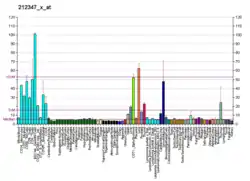MXD4
Max-interacting transcriptional repressor MAD4 is a protein that in humans is encoded by the MXD4 gene.[4][5]
| MXD4 | |||||||||||||||||||||||||
|---|---|---|---|---|---|---|---|---|---|---|---|---|---|---|---|---|---|---|---|---|---|---|---|---|---|
| Identifiers | |||||||||||||||||||||||||
| Aliases | MXD4, MAD4, MST149, MSTP149, bHLHc12, MAX dimerization protein 4 | ||||||||||||||||||||||||
| External IDs | MGI: 104991 HomoloGene: 4712 GeneCards: MXD4 | ||||||||||||||||||||||||
| |||||||||||||||||||||||||
| |||||||||||||||||||||||||
| Orthologs | |||||||||||||||||||||||||
| Species | Human | Mouse | |||||||||||||||||||||||
| Entrez | |||||||||||||||||||||||||
| Ensembl | |||||||||||||||||||||||||
| UniProt | |||||||||||||||||||||||||
| RefSeq (mRNA) | |||||||||||||||||||||||||
| RefSeq (protein) |
| ||||||||||||||||||||||||
| Location (UCSC) | Chr 4: 2.25 – 2.26 Mb | n/a | |||||||||||||||||||||||
| PubMed search | [2] | [3] | |||||||||||||||||||||||
| Wikidata | |||||||||||||||||||||||||
| |||||||||||||||||||||||||
Function
This gene is a member of the MAD gene family . The MAD genes encode basic helix-loop-helix-leucine zipper proteins that heterodimerize with MAX protein, forming a transcriptional repression complex. The MAD proteins compete for MAX binding with MYC, which heterodimerizes with MAX forming a transcriptional activation complex. Studies in rodents suggest that the MAD genes are tumor suppressors and contribute to the regulation of cell growth in differentiating tissues.[5]
References
- GRCh38: Ensembl release 89: ENSG00000123933 - Ensembl, May 2017
- "Human PubMed Reference:". National Center for Biotechnology Information, U.S. National Library of Medicine.
- "Mouse PubMed Reference:". National Center for Biotechnology Information, U.S. National Library of Medicine.
- Hurlin PJ, Quéva C, Koskinen PJ, Steingrímsson E, Ayer DE, Copeland NG, Jenkins NA, Eisenman RN (November 1995). "Mad3 and Mad4: novel Max-interacting transcriptional repressors that suppress c-myc dependent transformation and are expressed during neural and epidermal differentiation". The EMBO Journal. 14 (22): 5646–59. doi:10.1002/j.1460-2075.1995.tb00252.x. PMC 394680. PMID 8521822.
- "Entrez Gene: MXD4 MAX dimerization protein 4".
Further reading
- Rual JF, Venkatesan K, Hao T, Hirozane-Kishikawa T, Dricot A, Li N, Berriz GF, Gibbons FD, Dreze M, Ayivi-Guedehoussou N, Klitgord N, Simon C, Boxem M, Milstein S, Rosenberg J, Goldberg DS, Zhang LV, Wong SL, Franklin G, Li S, Albala JS, Lim J, Fraughton C, Llamosas E, Cevik S, Bex C, Lamesch P, Sikorski RS, Vandenhaute J, Zoghbi HY, Smolyar A, Bosak S, Sequerra R, Doucette-Stamm L, Cusick ME, Hill DE, Roth FP, Vidal M (October 2005). "Towards a proteome-scale map of the human protein-protein interaction network". Nature. 437 (7062): 1173–8. Bibcode:2005Natur.437.1173R. doi:10.1038/nature04209. PMID 16189514. S2CID 4427026.
- Marcotte R, Chen JM, Huard S, Wang E (December 2005). "c-Myc creates an activation loop by transcriptionally repressing its own functional inhibitor, hMad4, in young fibroblasts, a loop lost in replicatively senescent fibroblasts". Journal of Cellular Biochemistry. 96 (5): 1071–85. doi:10.1002/jcb.20503. PMID 16167342. S2CID 8251961.
- Pope SN, Lee IR (February 2005). "Yeast two-hybrid identification of prostatic proteins interacting with human sex hormone-binding globulin". The Journal of Steroid Biochemistry and Molecular Biology. 94 (1–3): 203–8. doi:10.1016/j.jsbmb.2005.01.007. PMID 15862967. S2CID 9746088.
- Jiang DJ, Yu HX, Hexige SY, Guo ZK, Wang X, Ma LJ, Chen Z, Zhao SY, Yu L (July 2004). "Human liver specific transcriptional factor TCP10L binds to MAD4". Journal of Biochemistry and Molecular Biology. 37 (4): 402–7. doi:10.5483/bmbrep.2004.37.4.402. PMID 15469726.
- Kime L, Wright SC (February 2003). "Mad4 is regulated by a transcriptional repressor complex that contains Miz-1 and c-Myc". The Biochemical Journal. 370 (Pt 1): 291–8. doi:10.1042/BJ20021679. PMC 1223147. PMID 12418961.
- Cairo S, Merla G, Urbinati F, Ballabio A, Reymond A (March 2001). "WBSCR14, a gene mapping to the Williams--Beuren syndrome deleted region, is a new member of the Mlx transcription factor network". Human Molecular Genetics. 10 (6): 617–27. doi:10.1093/hmg/10.6.617. PMID 11230181.
- Billin AN, Eilers AL, Queva C, Ayer DE (December 1999). "Mlx, a novel Max-like BHLHZip protein that interacts with the Max network of transcription factors". The Journal of Biological Chemistry. 274 (51): 36344–50. doi:10.1074/jbc.274.51.36344. PMID 10593926.
External links
- MXD4+protein,+human at the US National Library of Medicine Medical Subject Headings (MeSH)
This article incorporates text from the United States National Library of Medicine, which is in the public domain.
This article is issued from Wikipedia. The text is licensed under Creative Commons - Attribution - Sharealike. Additional terms may apply for the media files.




